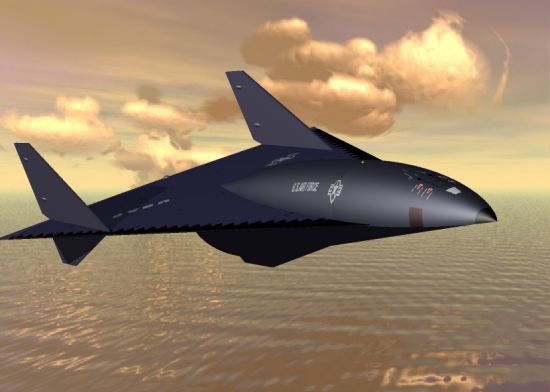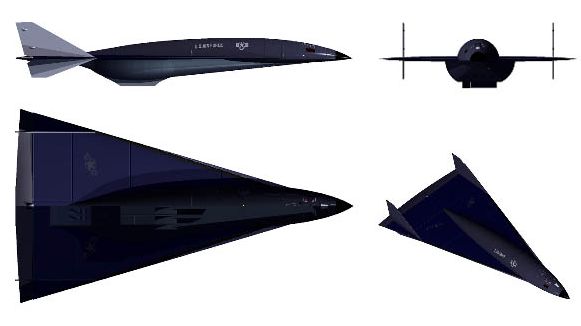|
||||||||||
|
|
||||||||||
|
||||||||||
|
|
||||||||||
 - -
|
|

|
Aurora Strategic Reconnaissance |
|
DESCRIPTION:
The name "Aurora" first appeared in a 1985 budget document with a line by that name slated to receive $80 million in FY 1986 and $2.2 billion in FY 1987. Since the item appeared just after the TR-1, many conjectured this project was a high-speed reconnaissance aircraft to replace the SR-71. As early as 1979, the Air Force had begun studying a "...Mach 4, 200,000-ft.-altitude aircraft that could be a follow-on to the Lockheed SR-71 strategic reconnaissance vehicle in the 1990s." The Air Force, NASA, and several aerospace contractors undertook design studies of Mach 5 aircraft throughout the early and mid-1980s that may have supplied the basic information needed to develop such a concept. The principal difficulties these studies had to address were the development of engines able to power an aircraft at speeds exceeding Mach 5 and developing structures capable of surviving the intense aerodynamic heating experienced at such high speeds (see the Aerospaceweb.org Hypersonic Waverider site to learn more about high-speed flight). If it does exist, many conjecture the Aurora may look something like the Mach 3 XB-70 Valkyrie or NASA's cancelled X-30 National Aerospace Plane (NASP). Both vehicles were wedge-shaped with delta wings of small area. Both combated heating issues by circulating onboard fuel along surfaces experiencing the greatest heat fluxes. While the XB-70 was propelled by conventional jet engines, the X-30 was to have been powered by advanced ramjet or scramjet engines using cryogenic fuels to operate at speeds exceeding Mach 5. Based on this technological progression and close scrutiny of the US budget, many observers are convinced the US Air Force was able to develop, build, and test a large high-speed aircraft by the early 1990s. Shortly thereafter, reports of loud sonic booms and sightings of strange contrails over Great Britain and southern California began to surface. Some believe these reports provide further evidence of a very high-speed aircraft using some exotic form of propulsion. It is interesting to note, however, that these reports rapidly trailed off after 1996 suggesting that whatever vehicle mentioned in these sightings may have been only an experimental prototype no longer in use. The US government has repeatedly denied the existence of an aircraft called Aurora or any similar follow-on aircraft to replace the SR-71. Since the evidence supporting the Aurora is circumstantial or pure conjecture, there is little reason to contradict the government's position.
Data below estimated and completey conjectural |
|
| HISTORY: | |
| First Flight | possibly late-1980s |
|
Service Entry
|
existence unconfirmed
|
| CREW: |
possibly two: pilot and systems officer
|
|
ESTIMATED COST:
|
unknown
|
| AIRFOIL SECTIONS: | |
| Wing Root | unknown |
|
Wing Tip
|
unknown
|
| DIMENSIONS: | |
| Length | 115 ft (35 m) |
| Wingspan | 65 ft (20 m) |
| Height | 19 ft (6 m) |
| Wing Area | 3,200 ft² (300 m²) |
|
Canard Area
|
not applicable
|
| WEIGHTS: | |
| Empty | 65,000 lb (29,480 kg) |
| Normal Takeoff | unknown |
| Max Takeoff | 157,000 lb (71,215 kg) |
| Fuel Capacity |
internal: 88,000 lb (39,920 kg) external: not applicable |
|
Max Payload
|
4,000 lb (1,815 kg)
|
| PROPULSION: | |
| Powerplant |
possibly turbofan engines for subsonic flight and ramjets, scramjets, or pulse detonation engines for supersonic flight |
| Thrust |
unknown
|
| PERFORMANCE: | |
| Max Level Speed |
at altitude: possibly Mach 5 to Mach 8 (some suggest up to Mach 20) at sea level: unknown |
| Initial Climb Rate | unknown |
| Service Ceiling | 131,000 ft (40,000 m) |
| Range | 8,000 nm (15,000 km) |
| g-Limits |
unknown
|
| ARMAMENT: | |
| Gun | none |
| Stations | none |
| Air-to-Air Missile | none (although some suggest a long-range AAM like the AIM-54 Phoenix might be carried) |
| Air-to-Surface Missile | none |
| Bomb | none |
| Other |
cameras, IR sensors, other recon sensors
|
| KNOWN VARIANTS: | |
| Aurora |
Possible high-speed advanced reconnaissance platform
|
|
KNOWN COMBAT RECORD:
|
existence unconfirmed
|
|
KNOWN OPERATORS:
|
United States (US Air Force)
|
|
3-VIEW SCHEMATIC:

|
|
| SOURCES: | |


|
Aircraft | Design | Ask Us | Shop | Search |

|
|
| About Us | Contact Us | Copyright © 1997-2023 | |||
|
|
|||